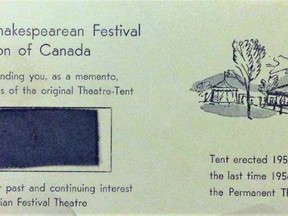Reflections: A treasured reminder of the Stratford Festival's beginnings
This is week 20 of a continuing series of articles celebrating the 50th anniversary of the Stratford-Perth Archives and its treasures.

Article content
“With one bold stroke that has left our big cities gasping, Stratford, Ont., famous mainly for producing Howie Morenz, will this summer claim its birthright with a Shakespearean festival starring Alec Guinness on the banks of the Avon,” proclaimed Maclean’s magazine on May 1, 1953.
This is week 20 of a continuing series of articles celebrating the 50th anniversary of the Stratford-Perth Archives and its treasures. This week’s treasure includes a piece of the original Shakespearean Festival tent, part of a larger donation to the archives in 2021. When it had served its original purpose, portions of the canvas from the tent were sent out as mementos to supporters in appreciation of past and continuing interest in the Canadian Festival Theatre.
The idea for a theatre in Stratford was started by one of Stratford’s most notable citizens, Tom Patterson, while he was attending the Stratford Collegiate in the 1930s. While pondering the future of the city with his school friends in the Shakespearean Gardens, as the story goes, his idea came to light.
In 1951, Stratford city council and the chamber of commerce began to look for new industries. The CNR’s steam locomotive repair shops were going to be phased out and something new was needed to revitalize – or even reinvent – Stratford.
In January 1952, Tom Patterson came forward with his proposal to the city for a new theatre. He made a presentation to council that caught the attention of the local newspaper, the Stratford Beacon Herald. The headline read:” Council told of idea to make Stratford world famous Shakespearean centre.” When Patterson completed his presentation, he asked council for $100 to go to New York to meet Sir Laurence Olivier. Council gave him $125. He went to New York, and though he did not get to meet Olivier, Patterson came back feeling encouraged to keep exploring the idea. Patterson’s commitment to this new endeavour never wavered, and he had the support from not only city council but also from the citizens.
The now-famous tent was erected in 1953 and people came out to see the first show, Richard III, starring Alec Guinness. The tent served well for the first four seasons from 1953 to 1956. Then a permanent building, the Festival Theatre, was built, but only after the Festival had proven itself financially.
The stage at the Festival is known as a thrust stage. The goal and concept of the thrust stage was introduced by artistic director Tyrone Guthrie. The goal was to create a stage that would have been similar to what Shakespeare would have used. A thrust stage lets the audience surround it on three sides, as opposed to a proscenium-style stage, which removes the audience from the action. Guthrie worked in tandem with designer Tanya Moiseiwitsch on the stage design, and it was built by Toronto architect Robert Fairfield. The first stage was covered by the tent and the peak of the tent was directly over the stage. When the permanent building was constructed, the thrust stage was still used.
Robert Fairfield also designed the new permanent building for the Festival to resemble the original tent structure. It was 200 feet in diameter and approximately 70 feet in height. It was constructed by a local construction company, Gaffney Construction. (In 2017, the Archives was also honoured to receive a large donation of building plans and contracts from Gaffney Construction Company.) It took 150 construction workers to complete the building by June 30, 1957. They had a dedication ceremony that same day and, on July 1, opened their fifth season. The new theatre included a balcony above the amphitheatre and there was seating for 2,276 people. In 1958, Fairfield won the Massey Gold Medal for Architecture for his design of the iconic building, though we still treasure this reminder of the Stratford Festival’s early years under the tent.
The Stratford-Perth Archives is open for in-person research by appointment. Service by phone and email remains an option. Please contact us at 519-271-0531 ext. 259 or archives@perthcounty.ca
Postmedia is committed to maintaining a lively but civil forum for discussion. Please keep comments relevant and respectful. Comments may take up to an hour to appear on the site. You will receive an email if there is a reply to your comment, an update to a thread you follow or if a user you follow comments. Visit our Community Guidelines for more information.